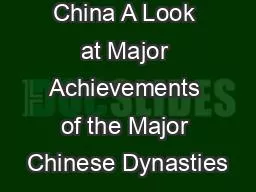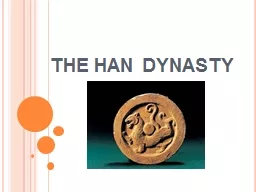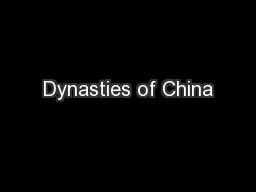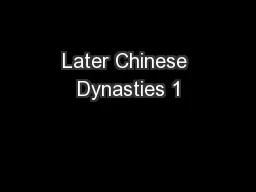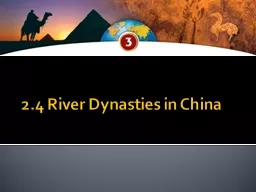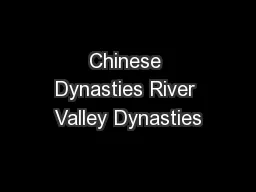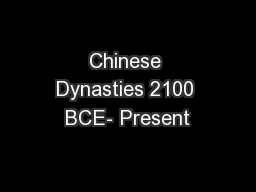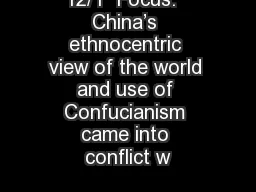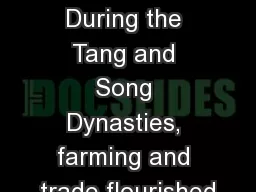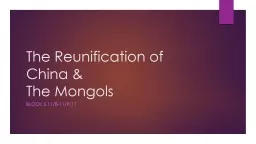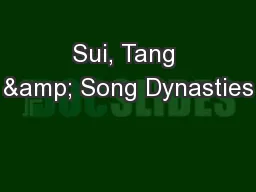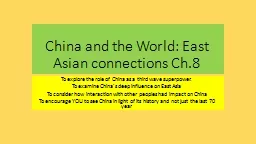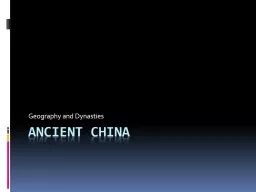PPT-History of China A Look at Major Achievements of the Major Chinese Dynasties
Author : coursion | Published Date : 2020-06-24
Dynasty A dynasty is a time period of a ruling family It could last anywhere from 1 to hundreds of years The Dynasty is named after the family name last name of
Presentation Embed Code
Download Presentation
Download Presentation The PPT/PDF document "History of China A Look at Major Achieve..." is the property of its rightful owner. Permission is granted to download and print the materials on this website for personal, non-commercial use only, and to display it on your personal computer provided you do not modify the materials and that you retain all copyright notices contained in the materials. By downloading content from our website, you accept the terms of this agreement.
History of China A Look at Major Achievements of the Major Chinese Dynasties: Transcript
Dynasty A dynasty is a time period of a ruling family It could last anywhere from 1 to hundreds of years The Dynasty is named after the family name last name of the ruling family TaiTsung Tang Dynasty 626649 Both the dragon motif and the yellow color are restricted to the royalty only. Wong. ewong5@binghamton.edu. With many thanks to: . Community engagement . program of . 2011. Professor: . Lisa . Yun. Graduate Assistant: Sandy woo . Department of Asian and Asian American studies. Binghamton university. THE HAN DYNASTY. OBJECTIVES. VIDEO. TWO MAJOR ACHIEVEMENTS. THE FALL OF THE HAN DYNASTY. ASSIGNMENT. OBJECTIVES. By the end of the lesson, you will be able to:. Describe . the two major achievements of the Han Dynasty. Use any and all information on these slides to use in your poster presentations and on the class timeline. XIA (A.K.A. HSIA) DYNASTY. (CA. 2070-CA. 1600 BCE). China’s first dynasty. Founded by Yu. Built roads and irrigation projects. . Question & Research Task. A . dynasty. is a chain of rulers that originate from one family or group. Chinese history is divided into dynastic periods. The earlier dynasties included the Qin and Han, and a period of disunity. Eventually, the different kingdoms were reunified. The Geography of China. Barriers Isolate China. Ocean, mountains, deserts isolate China from other areas. River Systems. Huang He. (“Yellow River”) in north. , Yangtze . in south. Huang He leaves . Archeological discovery of the . Xia. is still in its preliminary stage . Established about 2200 B.C.E. . Legendary King Yu. , the dynasty founder, a hero of flood control . Erlitou: possibly the capital city of the Xia. Chinese Dynasties. Xia (Hsia) Dynasty. 2100 – 1600 BCE. Archeological evidence that a pervious dynasty existed. Chinese Dynasties. Shang Dynasty. 1600 – 1050 BCE. Writing system. Walled Cities. Bronze technology. . . During the Qing dynasty, China attempted to isolate itself by restricting trade with western nations. . Important Terms: . Isolation, Ethnocentric . . Do Now:. What is meant by the term isolation? . China made great advances in art, literature, architecture, and technology under the rule of the Tang and Song. Do Now:. What Chinese philosophy was reflected in the Tang government?. . Chinese Empires. The Mongols. Block 2 11/8-11/9/17. Bellwork. : Block 2 . How did the Sui, Tang, and Song dynasties bring order to China between periods of chaos and instability?. Three Dynasties. The Sui reunified China after centuries of disorder and civil war. . Global I: Spiconardi. Sui Dynasty (581 C.E. – 618 C.E.). Sui. In 581 C.E., Yang . Jian. (Emperor . Wen. ) reunites China by founding the Sui Dynasty. The Sui supported both Buddhism & Daoism. Emperor . To explore the role of China as a third wave superpower.. To examine China’s deep influence on East Asia. To consider how interaction with other peoples had impact on China. To encourage YOU to see China in light of its history and not just the last 70 year. Edubull is providing Chinese Language Course Online. Here Learn to speak Chinese with Chinese Language Basics, introduction to the Chinese Language Classes with the Chinese Language Learning App. China. China is the 4. th. largest country in the world today. Most populated country in the world today.. Geographic features isolated China.. Mountain. chains . and deserts separated China from the rest of Asia..
Download Document
Here is the link to download the presentation.
"History of China A Look at Major Achievements of the Major Chinese Dynasties"The content belongs to its owner. You may download and print it for personal use, without modification, and keep all copyright notices. By downloading, you agree to these terms.
Related Documents

